Antimicrobial Activity of Some Novel Armed Thiophene Derivatives and Petra/Osiris/Molinspiration (POM) Analyses
Abstract
:1. Introduction
2. Results and Discussion
2.1. Synthesis
2.2. Antimicrobial Evaluation
2.3. Molecular Docking
2.4. POM Analyses
2.4.1. Osiris Calculations
2.4.2. Molinspiration Calculations
3. Experimental Section
3.1. Chemistry
3.1.1. General Information
3.1.2. Synthetic Procedures
General Procedure for the Condensation of Thiophene Derivative 5 with Heterocyclic or Aromatic Amines
3.2. Antimicrobial Activity
3.2.1. Antibacterial Activity
3.2.2. Antifungal Activity
4. Conclusions
Acknowledgments
Author Contributions
Conflicts of Interest
References
- Bohlman, F.; Zdero, C. Thiophene and Its Derivatives; Gronowitz, S., Ed.; John Wiley & Sons, Ltd.: Chichester, UK, 1986; Part 3; pp. 261–323. [Google Scholar]
- Perry, N.B.; Blunt, J.W.; Munro, M.H.G. Cytotoxic pigments from New Zealand sponges of the genus latrunculia: Discorhabdins A, B and C. Tetrahedron 1988, 44, 1727–1734. [Google Scholar] [CrossRef]
- Kobayashi, J.; Cheng, J.-F.; Ishibashi, M.; Nakamura, H.; Ohizumi, Y.; Hirata, Y.; Sasaki, T.; Lu, H.; Clardy, J.; Prianosin, A. A novel antileukemic alkaloid from the Okinawan marine sponge Prianosmelanos. Tetrahedron Lett. 1987, 28, 4939–4942. [Google Scholar] [CrossRef]
- Press, J.B. Thiophene and its derivatives. In The Chemistry of Heterocyclic Compounds, Part 4; Gronowitz, S., Ed.; John Wiley & Sons, Inc.: New York, NY, USA, 1991; Volume 44, pp. 397–502. [Google Scholar]
- Xiaoyun, L.; Baojie, W.; Scott, G.F.; Qidong, Y. Design, synthesis and anti-tubercular evaluation of new 2-acylated and 2-alkylated amino-5-(4-(benzyloxy)phenyl)thiophene-3-carboxylic acid derivatives, Part 1. Eur. J. Med. Chem. 2011, 46, 3551–3563. [Google Scholar]
- Hartman, G.D.; Ansdale, P.A. Substituted Thieno[2,3-b]thiophene-2-sulfonamides as Antiglaucoma Agents. U.S. Patent 4,806,562, 24 October 1989. [Google Scholar]
- Hafez, H.N.; El-Gazzar, A.B.A. Design and synthesis of 3-pyrazolyl-thiophene, thieno[2,3-d]pyrimidines as new bioactive and pharmacological activities. Bioorg. Med. Chem. Lett. 2008, 18, 5222–5227. [Google Scholar] [CrossRef] [PubMed]
- Fiesselmann, H. Thiophene synthesis. In Name Reactions, 3rd ed.; Li, J.J., Ed.; Springer: Berlin, Germany, 2006; p. 230. [Google Scholar]
- Gabar, H.M.; Bagley, M.C. Regioselective synthesis and biological evaluation of some novel thiophene containing heterocyclic scaffolds as potential chemotherapeutic agents. Eur. J. Chem. 2011, 2, 214–222. [Google Scholar] [CrossRef]
- Josué, S.B.F.; Erika, M.D.C.; Joel, J.J.; Flavia, M.D.S. A new protocol for the synthesis of 2-aminothiophnes through the Gewald reaction in solvent-free conditions. Heterocycl. Lett. 2011, 1, 61–67. [Google Scholar]
- Sommen, G.; Comel, A.; Kirsch, G. Preparation of thieno[2,3-b]pyrroles starting from ketene-N,S-acetals. Tetrahedron 2003, 59, 1557–1564. [Google Scholar] [CrossRef]
- David, T.; Enrico, P.; Dorothe’e, H.; Zhanjie, X.; Serge, S.; Stéphanie, H.; Gilbert, K.; Pierre, S. One-pot synthesis of new tetrasubstitutedthiophenes and selenophenes. Tetrahedron 2009, 65, 10453–10458. [Google Scholar]
- Bayrak, H.; Demirbas, A.; Demirbas, N.; Karaoglu, S. Synthesis of some new 1,2,4-triazoles starting from isonicotinic acid hydrazide and evaluation of their antimicrobial activities. Eur. J. Med. Chem. 2009, 44, 4362–4366. [Google Scholar] [CrossRef] [PubMed]
- Güzeldemirci, N.U.; Küçükbasmaci, O. Synthesis and antimicrobial activity evaluation of new 1,2,4-triazoles and 1,3,4-thiadiazoles bearing imidazo[2,1-b]thiazole moiety. Eur. J. Med. Chem. 2010, 45, 63–68. [Google Scholar] [CrossRef] [PubMed]
- Mikami, Y.; YazawaUno, K.J.; Matsumae, A. In vitro activity of amphotericin B, flucytosine, fluconazole and miconazole against clinically isolated Candida albicans, Aspergillus funigatus and Trichosporon beigelii. Chemotherapy 1990, 38, 1039–1047. [Google Scholar]
- Tozkoparan, B.; Küpeli, E.; Yesilada, E.; Ertan, M. Preparation of 5-aryl-3-alkylthio-l,2,4-triazoles and corresponding sulfones with antiinflammatory–analgesic activity. Bioorg. Med. Chem. 2007, 15, 1808–1814. [Google Scholar] [CrossRef] [PubMed]
- Abdel-Megeed, A.M.; Abdel-Rahman, H.M.; Alkaramany, G.-E.S.; El-Gendy, M.A. Design, synthesis and molecular modeling study of acylated 1,2,4-triazole-3-acetates with potential anti-inflammatory activity. Eur. J. Med. Chem. 2009, 44, 117–123. [Google Scholar] [CrossRef] [PubMed]
- Holla, B.S.; Veerandra, B.; Shivananda, M.K.; Poojary, B. Synthesis characterization and anticancer activity studies on some Mannich bases derived from 1,2,4-triazoles. Eur. J. Med. Chem. 2003, 38, 759–767. [Google Scholar] [CrossRef]
- Deepika, S.; Balasubramanian, N.; Pradeep, K.; Abraham, J. Synthesis and QSAR evaluation of 2-(substituted phenyl)-1H-benzimidazoles and [2-(substituted phenyl)-benzimidazol-1-yl]-pyridin-3-yl-methanones. Eur. J. Med. Chem. 2009, 44, 1119–1127. [Google Scholar]
- Tewari, A.K.; Mishra, A. Synthesis and antiviral activities of N-substituted-2-substituted-benzimidazole derivatives. Indian J. Chem. 2006, 45B, 489–493. [Google Scholar] [CrossRef]
- Demirayak, S.; Mohsen, U.A.; Karaburun, A.C. Synthesis and anticancer and anti-HIV testing of some pyrazino [1,2-a]benzimidazole derivatives. Eur. J. Med. Chem. 2002, 37, 255–260. [Google Scholar] [CrossRef]
- Penning, T.D.; Zhu, G.; Gandhi, V.V.; Gong, J.; Thomas, S.; Lubisch, W. Discovery and SAR of 2-(1-propylpiperidin-4-yl)-1H-benzimidazole-4-carboxamide: A potent inhibitor of poly (ADP-ribose) polymerase (PARP) for the treatment of cancer. Bioorg. Med. Chem. 2008, 16, 6965–6975. [Google Scholar] [CrossRef] [PubMed]
- Kus, C.; Atlanlar, N. Synthesis of some new benzimidazolecarbamate derivatives for evaluation of antifungal activity. Turk. J. Chem. 2003, 27, 35–39. [Google Scholar]
- Ayhan-Kilcigil, G.; Kus, C.; Ozdamar, E.D.; Can-Eke, B.; Iscan, M. Synthesis and antioxidant capacities of some new benzimidazole derivatives. Arch. Pharm. Chem. Life Sci. 2007, 340, 607–611. [Google Scholar] [CrossRef] [PubMed]
- Mabkhot, Y.N.; Kheder, N.A.; Al-Majid, A.M. Facile and convenient synthesis of newthieno[2,3-b]thiophene derivatives. Molecules 2010, 15, 9418–9426. [Google Scholar] [CrossRef] [PubMed]
- Mabkhoot, Y.N. Synthesis and analysis of some bis-heterocyclic compounds containing sulphur. Molecules 2009, 14, 1904–1914. [Google Scholar] [CrossRef] [PubMed]
- Mabkhoot, Y.N.; Al-Majid, A.M.; Barakat, A.; Alshahrani, S.; Siddiqui, Y. 1,1’-(3-Methyl-4-phenylthieno[2,3-b]thiophene-2,5-diyl)diethanone as a building block in heterocyclic synthesis. novel synthesis of some pyrazole and pyrimidine derivatives. Molecules 2011, 16, 6502–6511. [Google Scholar] [CrossRef] [PubMed]
- Mabkhoot, Y.N.; Kheder, N.A.; Farag, A.M. Synthesis and antimicrobial activity of some newthieno[2,3-b]thiophene derivatives. Molecules 2013, 18, 4669–4678. [Google Scholar] [CrossRef] [PubMed]
- Vaara, M. Antibiotic-supersusceptible mutants of Escherichia coli and Salmonella typhimurium. Antimicrob. Agents Chemother. 1993, 37, 2255–2260. [Google Scholar] [CrossRef] [PubMed]
- Nikaido, H.; Vaara, M. Molecular basis of bacterial outer membrane permeability. Microbiol. Rev. 1985, 49, 1–32. [Google Scholar] [CrossRef] [PubMed]
- Plésiat, P.; Nikaido, H. Outer membranes of gram-negative bacteria are permeable to steroid probes. Mol. Microbiol. 1992, 6, 1323–1333. [Google Scholar] [CrossRef] [PubMed]
- Chemical Computing Group. Molecular Operating Environment (MOE); Chemical Computing Group Inc.: Montreal, QC, Canada, 2013. [Google Scholar]
- Osiris Software. Available online: http://www.organic-chemistry.org/prog/peo/ (accessed on 15 January 2016).
- Waring, M.J.; Ben-Hadda, T.; Kotchevar, A.T.; Ramdani, A.; Touzani, R.; Elkadiri, S.; Hakkou, A.; Bouakka, M.; Ellis, T. 2,3-Bifunctionalized Quinoxalines: Synthesis, DNA Interactions and Evaluation of Anticancer, Anti-tuberculosis and Antifungal Activity. Molecules 2002, 7, 641–656. [Google Scholar] [CrossRef]
- Ben Hadda, T.; Benchat, N.; El-Bali, B.; Abouricha, S.; Moueqqit, M.; Mimouni, M. Impact of Dimroth Rearrangement on anti-Tuberculosis Activity of 3-armed-Imidazo[1.2-a]pyrimidines IMP (-Pyridines) IP. Med. Pharm. Chem. 2003, 1–18. [Google Scholar]
- Anaflous, A.; Benchat, N.; Mimouni, M.; Abouricha, S.; Ben Hadda, T.; El-Bali, B.; Hakkou, A.; Hacht, B. Armed Imidazo[1,2-a]pyrimidines ((Pyridines): Evaluation of Antibacterial Activity. Lett. Drug Des. Discov. 2004, 1, 224–229. [Google Scholar] [CrossRef]
- Ben Hadda, T.; Rahima, B.; Kerbal, A.; Baba, B.F.; Akkurt, M.; Demailly, G.; Benazza, M. Synthesis and antitubercular activity of spiroheterocycles: 2,2′,4′,5′-tetra-substituted-1,2,2′,4′-tetrahydro-4H-spiro[isoquinoline-3,3′-pyrazol]-4-ones. Arkivoc 2007, 276–288. [Google Scholar]
- Ben Hadda, T.; Rahima, B.; Kerbal, A.; Baba, B.F.; Akkurt, M.; Demailly, G.; Benazza, M. Looking for a new antitubercular pharmacophore site: Synthesis and bioactivity of spiroheterocycles 2,3′,4′-tri-subsituted-1,2-dihydro-4H,4′H-spiro[isoquinoline-3,5′-isoxazol]-4-ones. Arkivoc 2008, 1–13. [Google Scholar]
- Houari, G.A.; Kerbal, A.; Bennani, B.; Baba, M.F.; Daoudi, M.; Ben Hadda, T. Drug design of new antitubercular agents: 1,3-dipolar cycloaddition reaction of arylnitriloxides and 3-para-methoxy-benzylidene-isochroman-4-ones. Arkivoc 2008, 42–50. [Google Scholar]
- Ben Hadda, T.; Genc, Z.K.; Masand, V.H.; Nebbache, N.; Warad, I.; Jodeh, S.; Genc, M.; Mabkhot, Y.N.; Barakat, A.; Salgado-Zamora, H. Computational POM and DFT Evaluation of Experimental in-vitro Cancer Inhibition of Staurosporine-Ruthenium(II) Complexes: The Power Force of Organometallics in Drug Design. Acta Chim. Slov. 2015, 62, 679–688. [Google Scholar] [CrossRef]
- Zunino, F.; Kotchevar, A.T.; Waring, M.; Daoudi, M.; Larbi, N.B.; Mimouni, M.; Sam, N.; Ben Hadda, T. Novel Cytotoxic Oxopyridoindolizines: iso-Propyl-7,8,9-tri-chloro-6,7,8,9-tetra-hydro-5-oxo-pyrido[2,3-a]indolizine-10-carboxylates. Molecules 2002, 7, 628–640. [Google Scholar] [CrossRef]
- Ben Hadda, T.; Kotchevar, A.T.; Daoudi, M.; Bennani, B.; Larbi, N.B.; Kerbal, A. Anti-tumour Activity of Some Polydentate N-Ligands: N,N-bis-(3-Substituted-5-Methylpyrazol-1yl Methyl) Arylamines and N,N,N′,N′-Tetra-[(3-Substituted-5-Methylpyrazol-1yl]Para-Phenylene diamines. Lett. Drug Des. Discov. 2005, 2, 584–589. [Google Scholar] [CrossRef]
- Bennani, B.; Kerbal, A.; Daoudi, M.; Baba, B.F.; Houari, G.A.; Jalbout, A.F.; Mimouni, M.; Benazza, M.; Demailly, G.; Akkurt, M.; et al. Combined drug design of potential Mycobacterium tuberculosis and HIV-1 inhibitors: 3’,4’-di-substituted -4’H-spiro[isothiochromene-3,5’-isoxazol]-4(1H)-one. Arkivoc 2007, 19–40. [Google Scholar]
- Ertl, P.; Rohde, B.; Selzer, P. Fast Calculation of Molecular Polar Surface Area as a Sum of Fragment-Based Contributions and Its Application to the Prediction of Drug Transport Properties. J. Med. Chem. 2000, 43, 3714–3717. [Google Scholar] [CrossRef] [PubMed]
- Jafri, L.; Ansari, F.L.; Jamil, M.; Kalsoom, S.; Qureishi, S.; Mirza, B. Microwave-assisted synthesis and bioevaluation of some semicarbazones. Chem. Biol. Drug Des. 2012, 79, 950–959. [Google Scholar] [CrossRef] [PubMed]
- Rehman, A.; Choudhary, M.I.; Thomsen, W.J. Bioassay Techniques for Drug Development; Harwood Academic Publishers: Amsterdam, The Netherlands, 2001. [Google Scholar]
- Arikan, S.; Paetznick, V.; Rex, J.H. Comparative evaluation of disk diffusion with microdilution assay in susceptibility testing of caspofungin against Aspergillus and Fusarium isolates. Antimicrob. Agents Chemother. 2002, 46, 3084–3087. [Google Scholar] [CrossRef] [PubMed][Green Version]

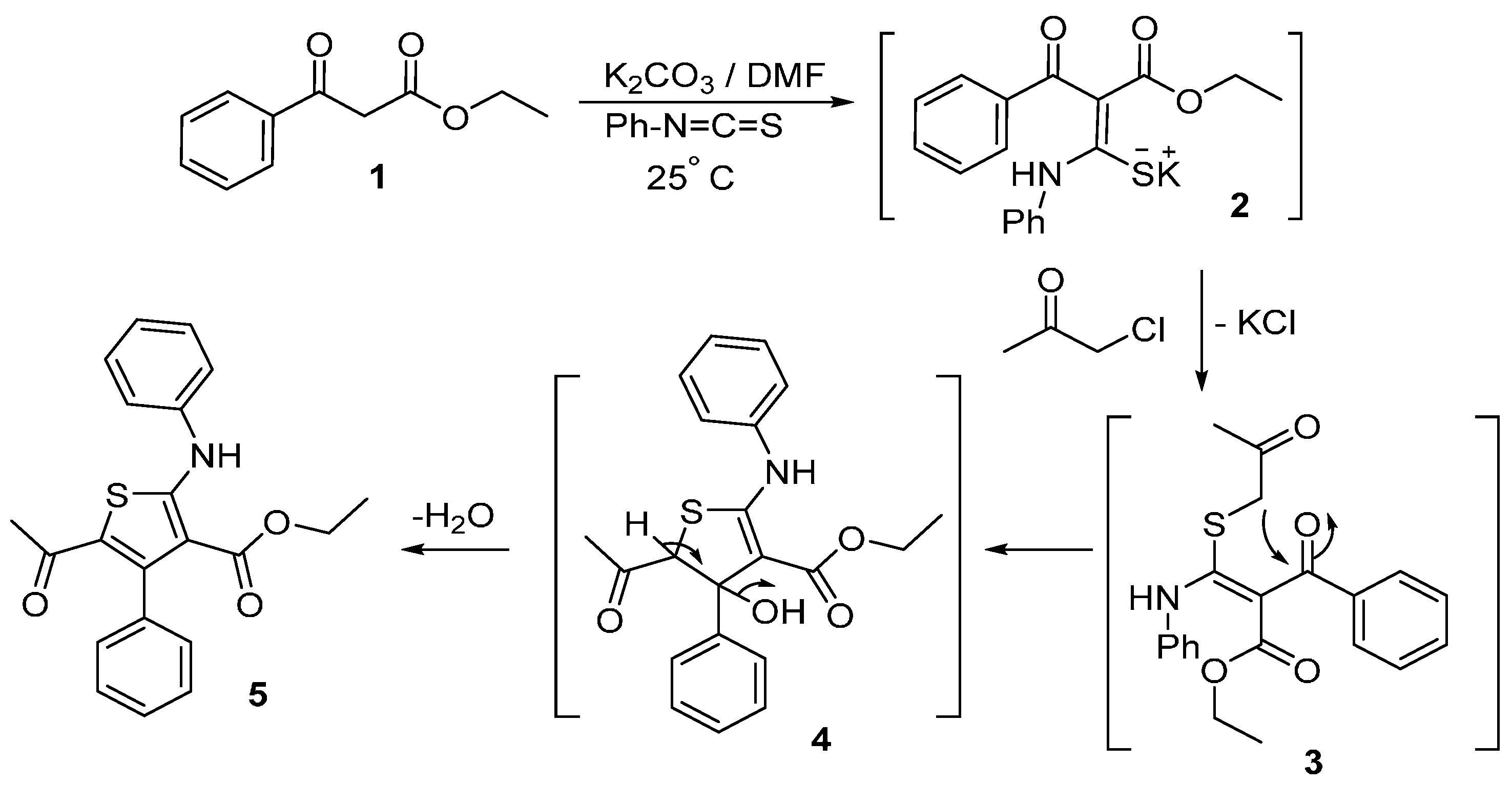


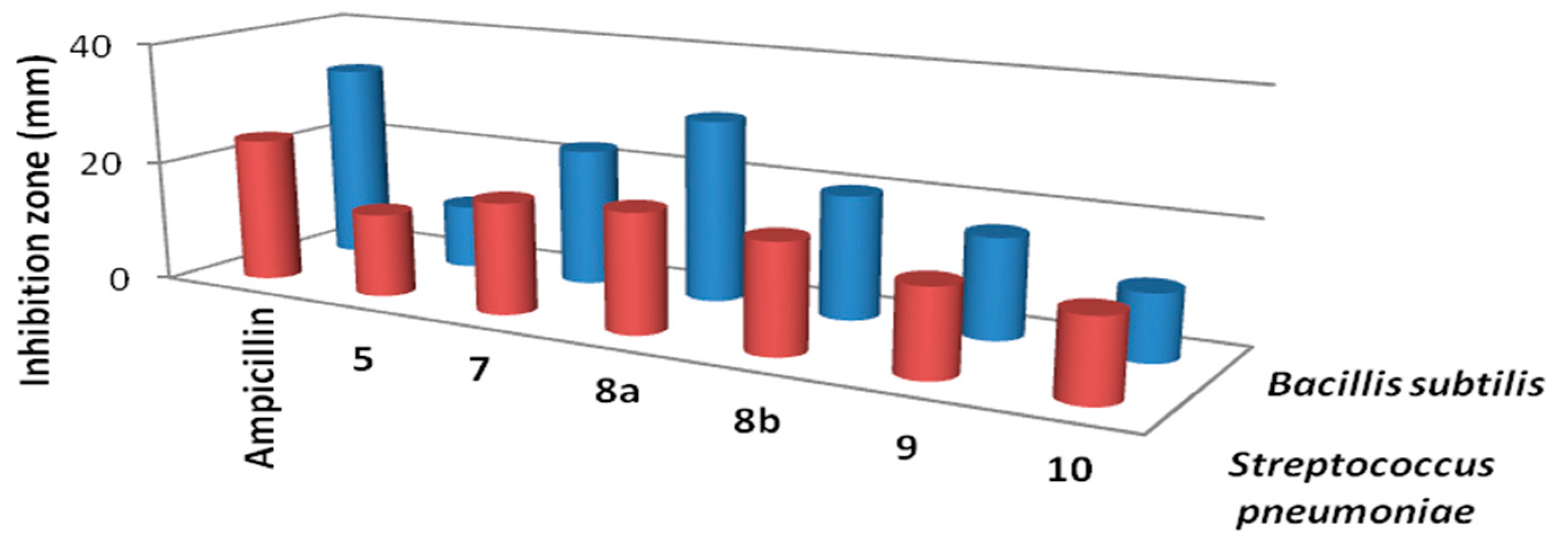
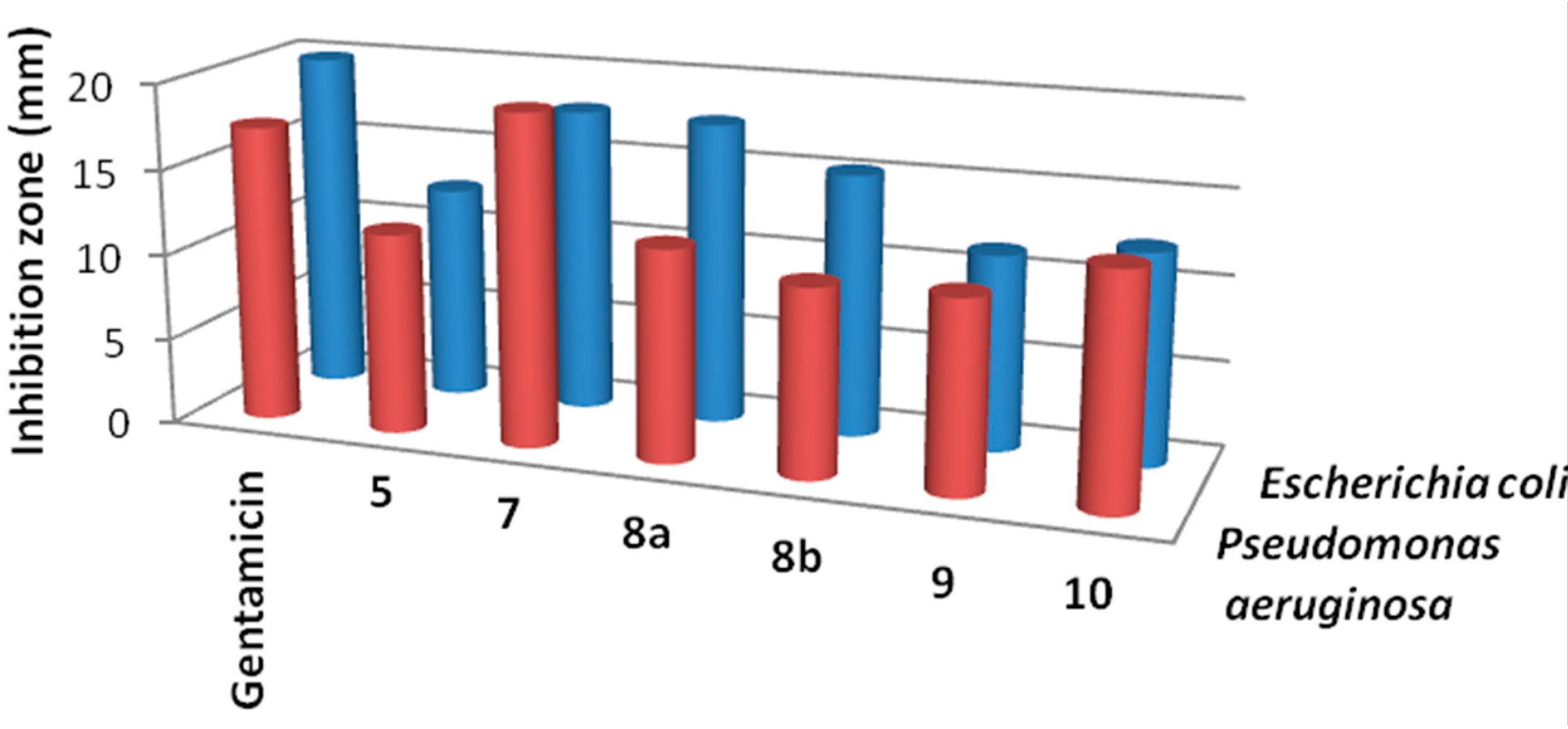

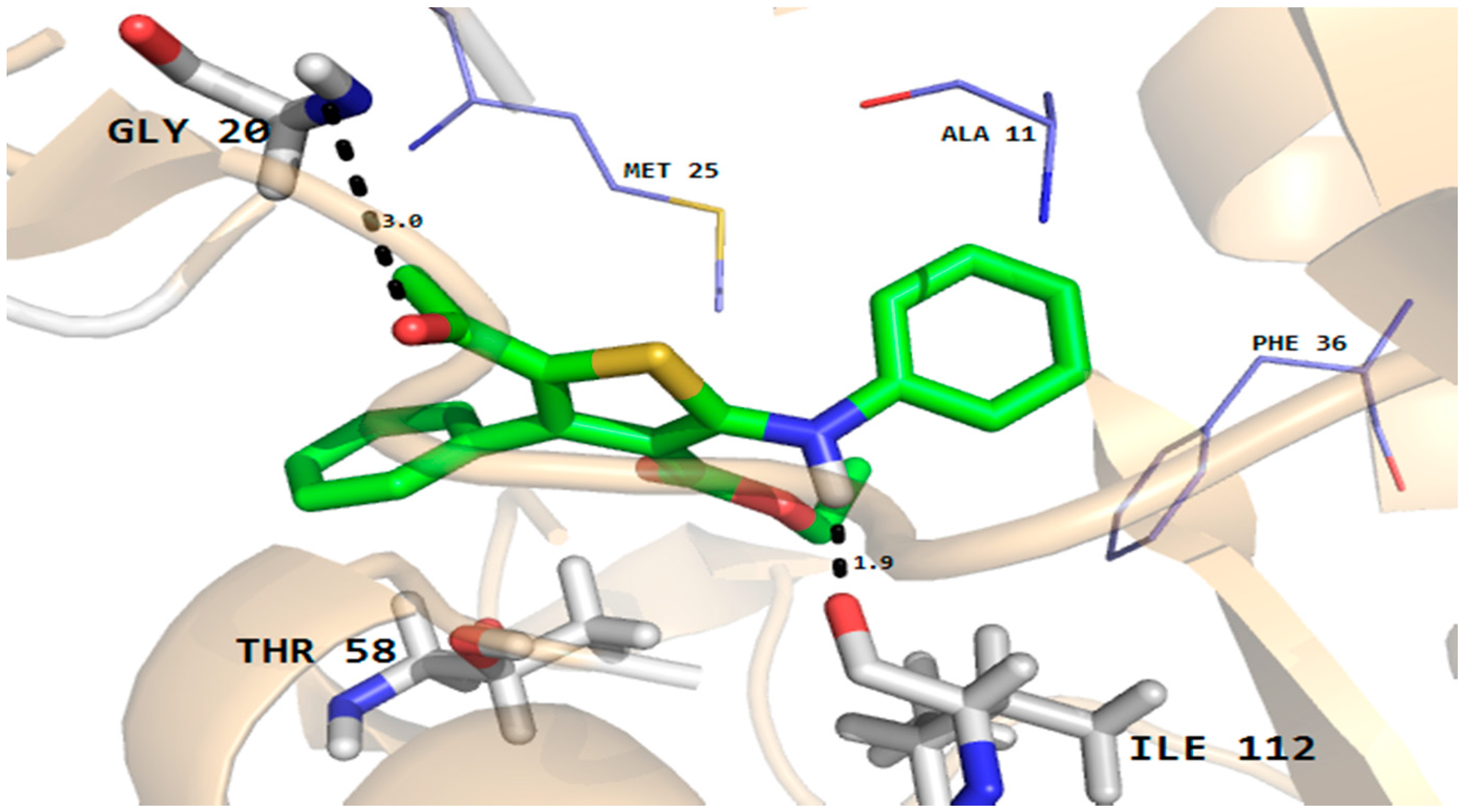
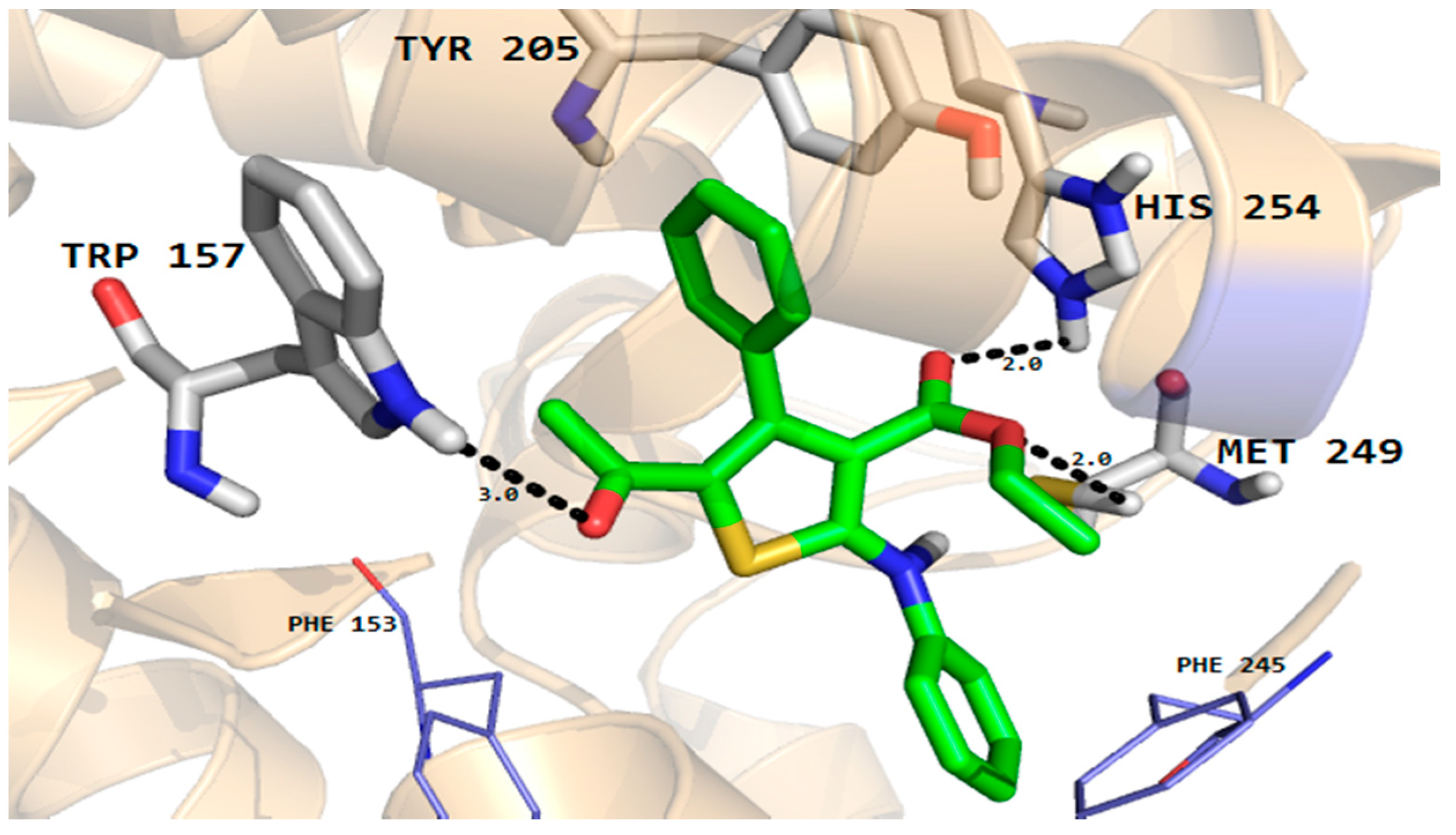
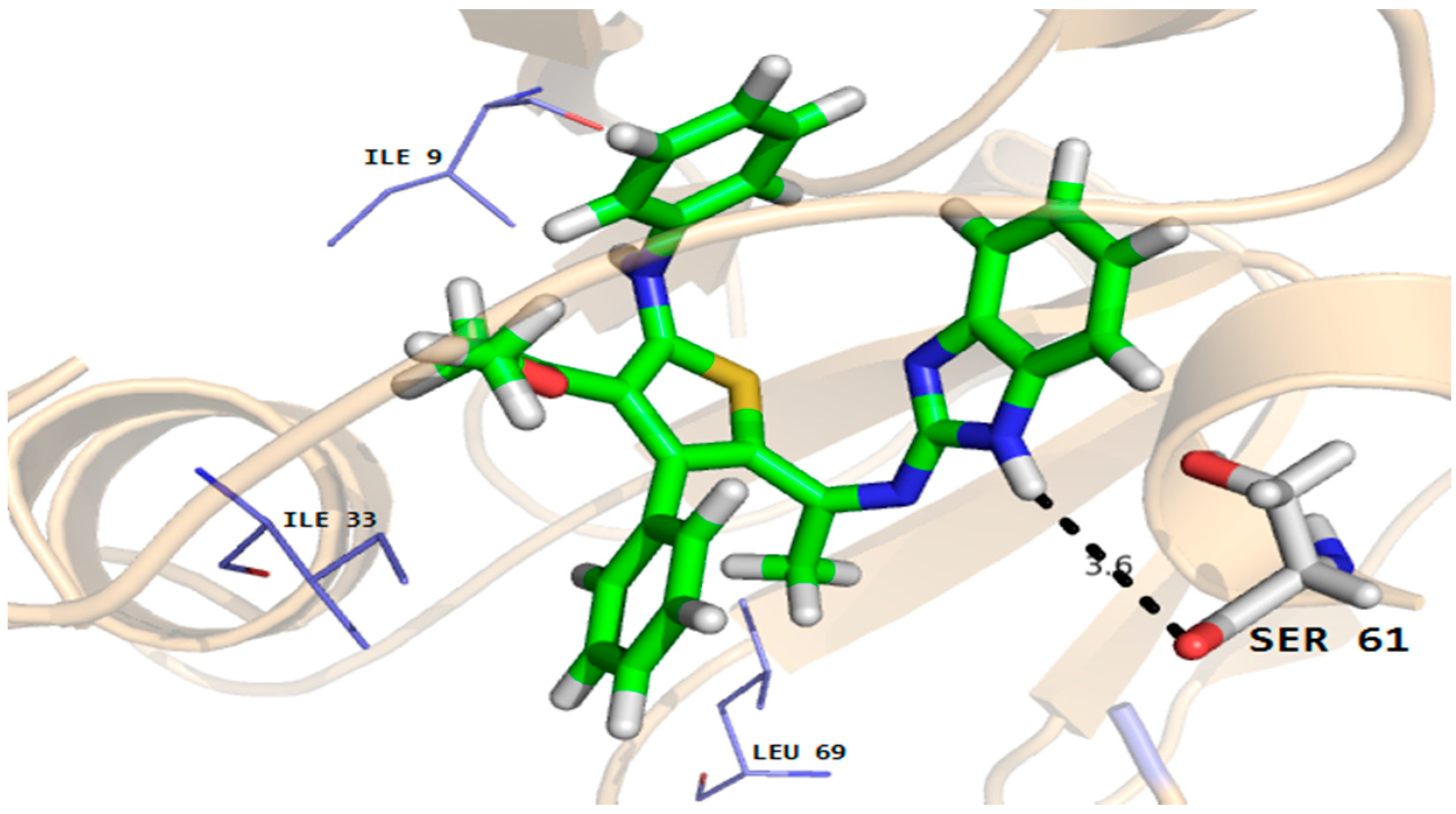
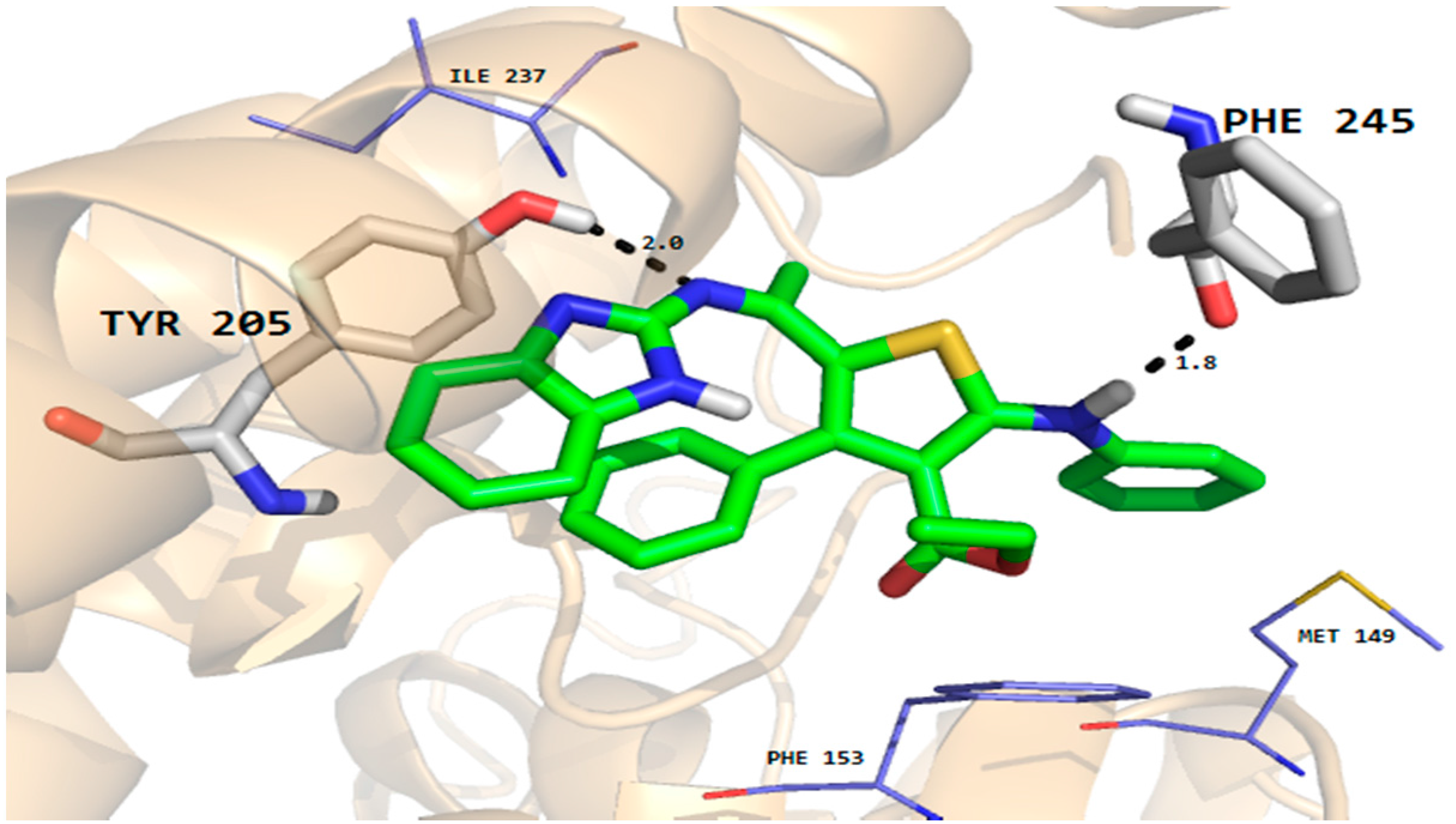

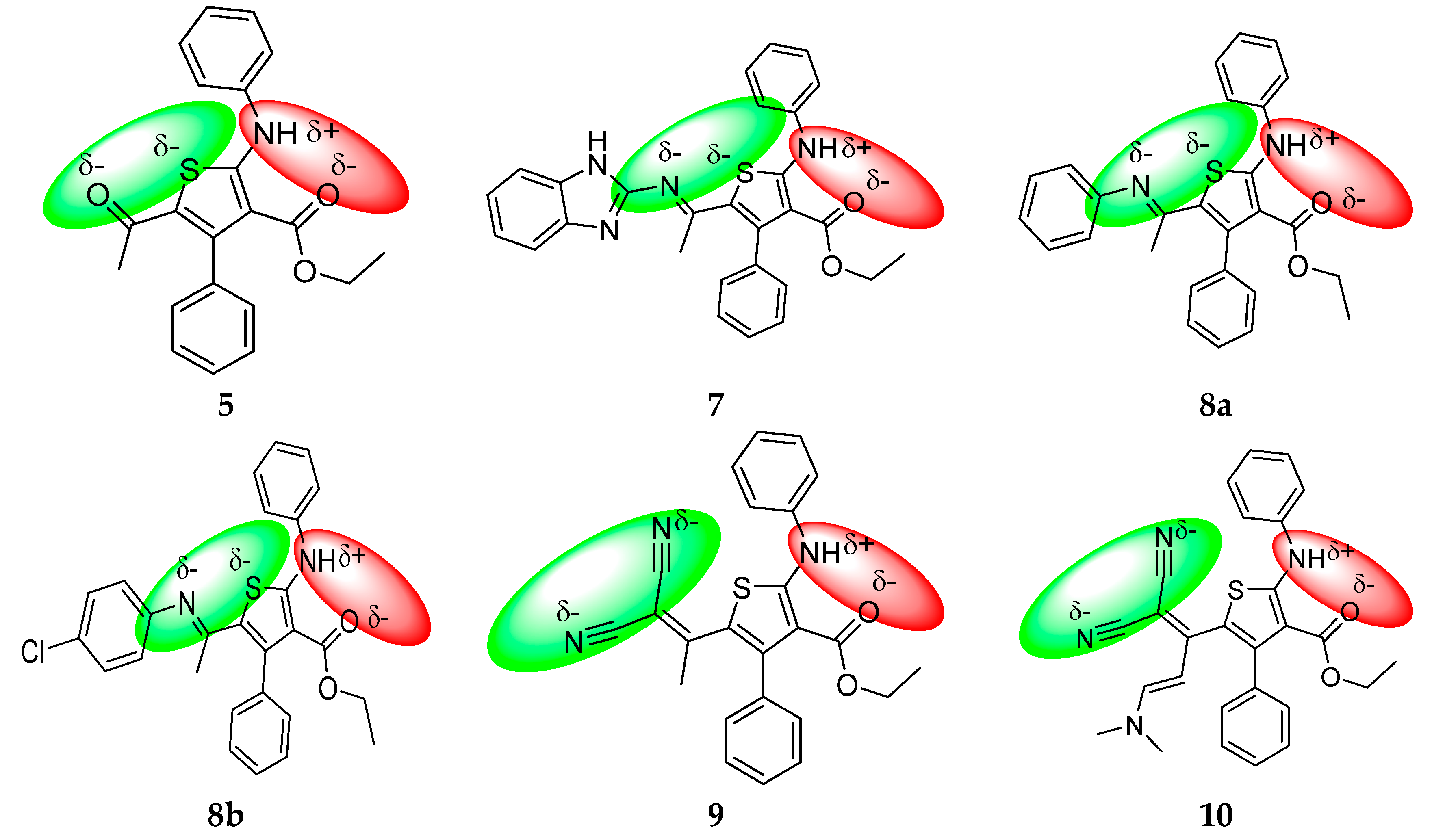
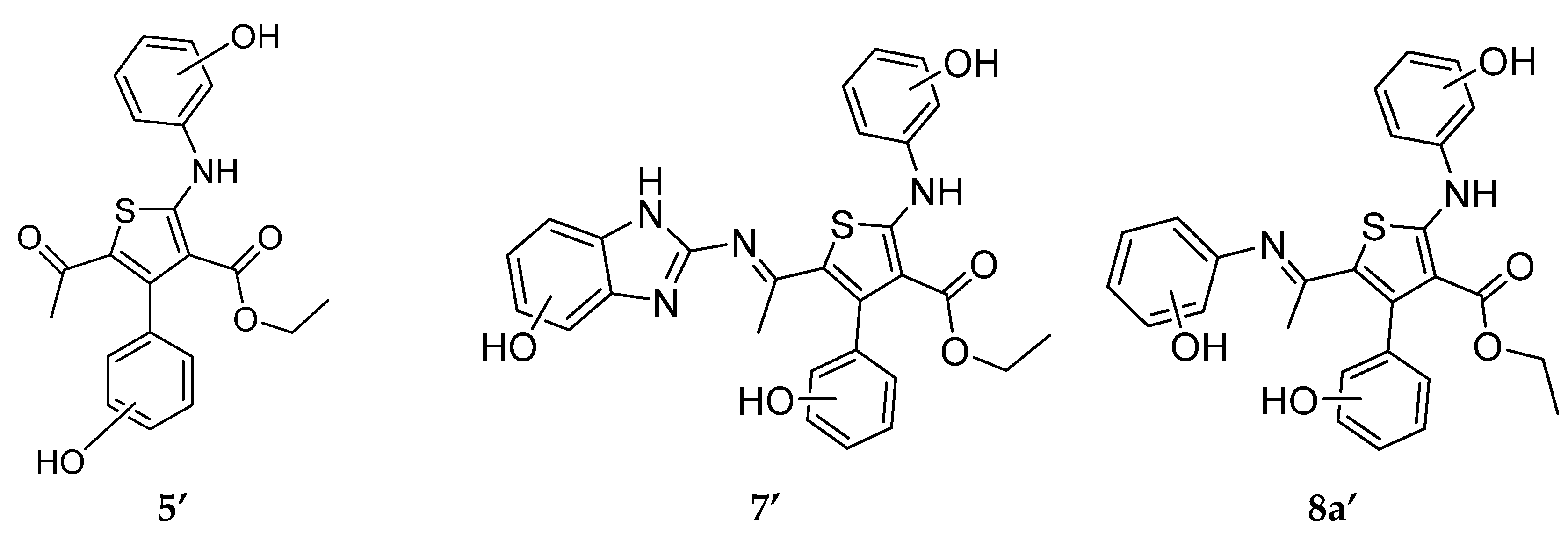

| Compound | Gram Positive Bacteria | Gram Negative Bacteria | ||
|---|---|---|---|---|
| Streptococcus pneumoniae | Bacillis subtilis | Pseudomonas aeruginosa | Escherichia coli | |
| 5 | 13.7 ± 0.31 | 10.5 ± 0.32 | 11.7 ± 0.41 | 12.5 ± 0.48 |
| 7 | 18.3 ± 0.25 | 22.6 ± 0.44 | 19.3 ± 0.52 | 17.8 ± 0.44 |
| 8a | 19.5 ± 0.44 | 29.8 ± 0.58 | 12.3 ± 0.25 | 17.6 ± 0.19 |
| 8b | 17.8 ± 0.58 | 20.1 ± 0.39 | 10.9 ± 0.31 | 15.3 ± 0.32 |
| 9 | 14.1 ± 0.52 | 16.3 ± 0.48 | 11.1 ± 0.42 | 11.4 ± 0.37 |
| 10 | 13.1 ± 0.43 | 10.8 ± 0.39 | 13.4 ± 0.34 | 12.3 ± 0.47 |
| Ampicillin | 23.8 ± 0.20 | 32.4 ± 0.30 | - | - |
| Gentamicin | - | - | 17.3 ± 0.11 | 19.9 ± 0.30 |
| Compound | Fungal Strains [a] | |||
|---|---|---|---|---|
| Aspergillus fumigates | Syncephalastrum racemosum | Geotricum candidum | Candida albicans | |
| 5 | 13.8 ± 0.42 | 14.1 ± 0.35 | 13.2 ± 0.34 | 10.8 ± 0.22 |
| 7 | 20.6 ± 0.58 | 16.7 ± 0.33 | 22.4 ± 0.36 | 17.6 ± 0.58 |
| 8a | 22.3 ± 0.25 | 16.5 ± 0.25 | 25.8 ± 0.58 | 12.3 ± 0.35 |
| 8b | 20.6 ± 0.35 | 14.8 ± 0.34 | 21.5 ± 0.62 | 10.9 ± 0.18 |
| 9 | 14.8 ± 0.42 | 15.3 ± 0.51 | 14.8 ± 0.46 | 11.9 ± 0.38 |
| 10 | 19.8 ± 0.63 | 16.8 ± 0.46 | 13.9 ± 0.48 | 14.6 ± 0.50 |
| SD [b] | 23.7 ± 0.1 | 19.7 ± 0.2 | 28.7 ± 0.2 | 25.4 ± 0.1 |
| Compound | MW | Toxicity Risks [a] | Drug-Score [b] | ||||||
|---|---|---|---|---|---|---|---|---|---|
| MUT | TUMO | IRRI | REP | CLP | S | DL | DS | ||
| 5 | 365 |  |  |  |  | 5.10 | −6.56 | −2.10 | 0.22 |
| 7 | 480 |  |  |  |  | 6.51 | −8.26 | −0.96 | 0.15 |
| 8a | 440 |  |  |  |  | 6.54 | −7.78 | −2.01 | 0.15 |
| 8b | 474 |  |  |  |  | 7.14 | −8.52 | −2.94 | 0.12 |
| 9 | 413 |  |  |  |  | 5.63 | −6.94 | −10.61 | 0.16 |
| 10 | 468 |  |  |  |  | 5.13 | −6.56 | −9.78 | 0.14 |
| SD1 [c] | 349 |  |  |  |  | −0.04 | −1.57 | 10.72 | 0.91 |
| SD2 [c] | 477 |  |  |  |  | −4.03 | −1.18 | 4.88 | 0.77 |
 : not toxic,
: not toxic,  : slightly toxic; [a] MUT: mutagenic, TUMO: tumorigenic, IRRI: irritant, REP: reproductive effective; [b] CLP: cLogP, S: Solubility, DL: Druglikness, DS: Drug-Score; [c] Standard drugs (SD1: ampicillin, SD2: gentamicin).
: slightly toxic; [a] MUT: mutagenic, TUMO: tumorigenic, IRRI: irritant, REP: reproductive effective; [b] CLP: cLogP, S: Solubility, DL: Druglikness, DS: Drug-Score; [c] Standard drugs (SD1: ampicillin, SD2: gentamicin).| Compound | Physico-Chemical Properties [a] | Drug Likeness [b] | |||||||||
|---|---|---|---|---|---|---|---|---|---|---|---|
| TPSA | ONH | VIOL | ROTB | VOL | GPC | ICM | KI | NRL | PI | EI | |
| 5 | 55 | 1 | 1 | 7 | 327 | −0.48 | −0.53 | −0.38 | −0.54 | −0.76 | −0.46 |
| 7 | 75 | 1 | 1 | 9 | 434 | −0.47 | −0.46 | −0.35 | −0.54 | −0.68 | −0.29 |
| 8a | 51 | 1 | 1 | 8 | 403 | −0.42 | −0.51 | −0.30 | −0.40 | −0.69 | −0.33 |
| 8b | 51 | 1 | 1 | 8 | 416 | −0.41 | −0.50 | −0.30 | −0.41 | −0.70 | −0.35 |
| 9 | 86 | 1 | 1 | 7 | 369 | −0.48 | −0.50 | −0.26 | −0.36 | −0.58 | −0.34 |
| 10 | 89 | 1 | 1 | 9 | 426 | −0.43 | −0.48 | −0.25 | −0.46 | −0.56 | −0.34 |
| SD1 [c] | 113 | 4 | 0 | - | 299 | −0.56 | −0.55 | −0.90 | −0.87 | NC | NC |
| SD2 [c] | 206 | 12 | 2 | - | 454 | −0.46 | −0.24 | −0.76 | −1.05 | NC | NC |
- Sample Availability: Samples of the compounds 5–10 are available from the authors.
© 2016 by the authors. Licensee MDPI, Basel, Switzerland. This article is an open access article distributed under the terms and conditions of the Creative Commons by Attribution (CC-BY) license ( http://creativecommons.org/licenses/by/4.0/).
Share and Cite
Mabkhot, Y.N.; Alatibi, F.; El-Sayed, N.N.E.; Al-Showiman, S.; Kheder, N.A.; Wadood, A.; Rauf, A.; Bawazeer, S.; Hadda, T.B. Antimicrobial Activity of Some Novel Armed Thiophene Derivatives and Petra/Osiris/Molinspiration (POM) Analyses. Molecules 2016, 21, 222. https://doi.org/10.3390/molecules21020222
Mabkhot YN, Alatibi F, El-Sayed NNE, Al-Showiman S, Kheder NA, Wadood A, Rauf A, Bawazeer S, Hadda TB. Antimicrobial Activity of Some Novel Armed Thiophene Derivatives and Petra/Osiris/Molinspiration (POM) Analyses. Molecules. 2016; 21(2):222. https://doi.org/10.3390/molecules21020222
Chicago/Turabian StyleMabkhot, Yahia Nasser, Fatima Alatibi, Nahed Nasser E. El-Sayed, Salim Al-Showiman, Nabila Abdelshafy Kheder, Abdul Wadood, Abdur Rauf, Saud Bawazeer, and Taibi Ben Hadda. 2016. "Antimicrobial Activity of Some Novel Armed Thiophene Derivatives and Petra/Osiris/Molinspiration (POM) Analyses" Molecules 21, no. 2: 222. https://doi.org/10.3390/molecules21020222
APA StyleMabkhot, Y. N., Alatibi, F., El-Sayed, N. N. E., Al-Showiman, S., Kheder, N. A., Wadood, A., Rauf, A., Bawazeer, S., & Hadda, T. B. (2016). Antimicrobial Activity of Some Novel Armed Thiophene Derivatives and Petra/Osiris/Molinspiration (POM) Analyses. Molecules, 21(2), 222. https://doi.org/10.3390/molecules21020222







